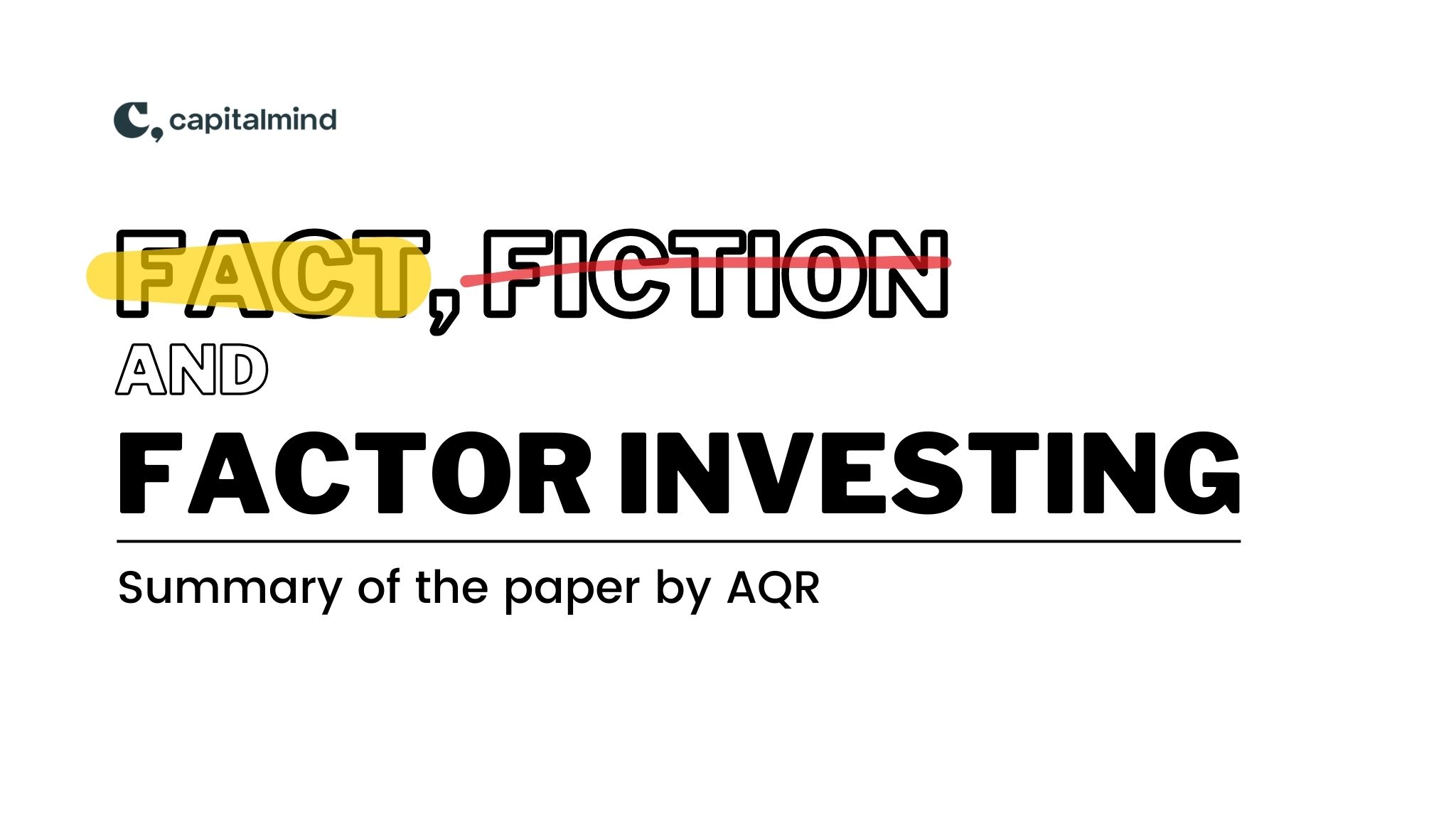This post is a summary of a recent paper, which is the post’s title, published by AQR in Jan 2023. It is a must-read for any investor trying to understand quantitative factor investing better. Since I hear from clients about the very myths and misconceptions tackled in this paper, and since the report is 35 pages, it just made sense to summarise the key takeaways of the paper, about what Factor Investing is, and isn’t. As one of the academically proven factors, everything here is directly applicable to Momentum Investing as well. You can download the full paper here.
Here’s the abstract of the paper.
Factor investing has been around for several decades, backed by an enormous body of literature, and yet it is still surrounded by much confusion and debate. Some of the rhetoric and myths have existed for a long time, while others have arisen in response to the difficult performance from 2018 to 2020 and the subsequent turnaround. This article examines many claims about factor investing; some are timeless, while others are focused on specific concerns that have emerged recently. The authors reference an extensive academic literature and perform simple, yet powerful, analysis to address these claims.
The bulk of this post is parts directly quoted from the paper. Those parts are formatted like the abstract above in italics. The rest is my commentary.
The authors define factor investing as
a systematic tilting toward a style/theme (and away from its polar opposite) implemented across a diversified set of assets. These tilts deviate from market weights and can be implemented in long-only or long–short portfolios. The themes or factors originate primarily from academia, motivated by economic theory and empirical study.
A simple analogy is that if you’re a scout looking to form a basketball team, you will look for players with specific physical attributes: tall, long arm span, good hand-eye coordination and so on. Those must-have attributes are the “factors” basis for selecting your team.
If this makes sense, it follows that a lot of investing is factor investing. Fundamental investors seek stocks that fit a specific profile, such as growing companies at reasonable prices, out-of-favour deep-value stocks, debt-reduction turnaround stories, etc. Each theme has a set of quantifiable factors associated, which form the basis for selection.
The authors address ten commonly-held “facts and fiction” about factor investing.
- Fiction: Factor investing is based on data-mined factors with no good economic story.
- Fact: Factors are risky.
- Fiction: Factor diversification often fails when you need it the most.
- Fact: Factors work across many markets and conditions.
- Fiction: Factors do not work anymore in the new economy.
- Fact: Factors were not and are not too crowded, despite being well known.
- Fiction: Everyone should invest in factors.
- Fact: Factor discipline generally trumps timing, tinkering, and trading.
- Fiction: You know when you are in a drawdown/recovery and when to cut/add risk.
- Fact: Sticking with factor investing is hard, but worth it.
The paper unpacks these with data to explain why they’ve classified them above.
1. Fiction: Factor investing is based on data-mined factors with no good economic story
As the phrase suggests, data mining is about mining data for insights. Looking through historical daily sales data to identify patterns about what items tend to sell more or less during what days/weeks/seasons can yield helpful insight for a retailer on what products to stock when and therefore drive sales and profit increase.
But data can yield real insight or just pure noise that looks like insight. Being able to tell the difference is crucial.
For example, if our retail store data told us that sales of certain items tend to be flat most of the time but see spikes at specific times, which on further digging, turn out to be times when they were on sale, it’s logical to conclude price-conscious customers prefer those brands. On the other hand, a finding that customers bought more butterscotch-flavoured ice cream than chocolate last month does not necessarily mean customer preferences have shifted and that you should stock more butterscotch flavour than chocolate next month. It could well be that you were out of chocolate last month and that your overall ice cream sales were down as a result.
The difference between the two above: Is there a logical explanation? In factor terms, the question becomes, Is there an economic theory or rationale for why a factor might deliver excess return over time? Those rationales fall into two buckets: Risk-based and Behavioral.
The Risk-based explanation says buying certain types of stocks is riskier than the market, and hence the investor buying them is being compensated for bearing the higher risk.
The Behavioral explanation says there are reasons why investors are on the other side of a factor trades. For example, excitable investors chasing recent growth trends would sell value-type stocks to pursue those. Contrarian investors who resist the herd sell stocks that have gone up substantially, whereas momentum investors buy those same stocks.
The table below summarises the popular factors and the rationale for why they have premiums
The other side of testing the validity of factors is the statistical tests that separate noise from insight, for instance:
- Probability tests, like the t-statistic, quantify to what extent the outcome could be explained by plain chance. An academic random portfolio experiment with 10-20-30 stock portfolios showed how 50% of random portfolios beat the index.
📈🔍A “random portfolio” experiment:
What if we picked 1,000 random equal-weight portfolios in Jan 2007 and held them all for 16 years?– How would they do versus the Nifty?
– How would their outcomes vary depending on the number of stocks they held?— Anoop (@CalmInvestor) April 14, 2023
- Out-of-sample tests, i.e. a factor, will show great returns over the period used in the analysis, but how does it do over a time frame not included in that initial analysis?
Examining a portfolio of factors is also a useful way to assess the data mining issue. For example, consider an equal-weighted portfolio of value, momentum, and defensive/quality factors applied to US individual stocks. Such a portfolio has a backtested Sharpe ratio of 1.1 with a t-statistic of 10.8, as documented by Ilmanen et al. (2021) using data from 1926 to 2020. As discussed earlier, data mining would have a hard time explaining a t-stat of nearly 11—it would take nearly a trillion random trials to get a t-statistic that large! Now, applying those same factors across markets and asset classes (and adding carry as well), the same authors find an annualized Sharpe ratio of 1.5 with a t-stat of more than 14! That amount of statistical signifi- cance, coupled with out-of-sample evidence from other markets and asset classes, casts serious doubt (read: astronomical odds) on data mining driving the significance of these factors.
But not all factors are created equal. Of over 400 factors discussed in academia, only a handful have passed all the tests mentioned above, clearly indicating some spurious data mining in many cases. Interestingly, the factors that receive the most attention, i.e. value, Momentum, carry and defensive/quality, satisfy the criteria of strong economic theory, strong in-sample significance, and consistent out-of-sample performance.
2. Fact: Factors are risky
By this, the authors mean that though some factors are proven, tried and tested, they are not immune to short-term pain.
Risk-based theories for factor premia require such painful periods. History shows that periods of underperformance can last several years. They can feel even longer when you are in the middle of one.
A historical analysis spanning multiple assets showed
each of these factors and multifactor portfolios, regardless of the asset class to which they were applied, experienced a meaningfully negative Sharpe ratio over some three-year period.
They go on to say that one way to handle the pain of being in one factor that happens to be underperforming at a given time is to combine multiple factors in the portfolio, essentially having exposure to more than one factor.
In addition to the investment horizon consideration, combining factors into a multifactor portfolio helps to mitigate tail events.
While it is never easy to live through a multi-year performance drawdown, these tough periods are inherent to a factor investment strategy and may indeed be necessary to generate factor premia in equilibrium. They are probably part and parcel of any successful long-term investing strategy that can be run at institutional scale (quant and non-quant).
I’ll put it this way: If a style of investing always did better than the market, managing never to lag the index, all capital would invariably flow to such a strategy making it, essentially, the market.
3. Fiction: Factor Diversification often fails when you need it most
There are two different versions of this claim. One version focuses on situations in which the factors “fail to diversify” each other, amidst terrible performance by one. The other version of this fiction is about times when factor investing “fails to diversify” bad market performance.
Two problems underly both versions of this fiction. The first problem is an excessive focus on the short term. Over short periods, the range of possible outcomes is larger (recall the fatter tails at shorter horizons we just covered), whereas longer term, one expects returns and correlations to converge to their expectations.
The second problem is mistaking diversification for a hedge. A hedge is an offsetting bet against risk that usually does not get rewarded long-term and often costs you something, (e.g., buying put options to protect against equity market downturns). In contrast, diversification merely requires that two return streams are not perfectly aligned (i.e., that their correlation is reasonably less than 1. This diversification can be very beneficial over time, but it does not make the diversifying asset a consistent hedge.
In probably overly simplified terms, equities as an asset class are highly correlated, especially in market downturns. Imagine holding multiple actively managed portfolios when markets decline. Those active portfolios, irrespective of how little they overlap, will likely decline, albeit to varying degrees. The same applies to different factors. However, some factors are less than perfectly correlated, which means a combined portfolio will do better than the worst-performing factor at the time.
4. Fact: Factors work across many markets and conditions
The original studies for value, momentum, and defensive/quality focus on US individual stocks, and the original studies on carry strategies apply them to developed market currencies. However, there is ample evidence that these factor themes apply easily and effectively to many other markets, other asset classes, and on subsets of assets within a market.
In addition, factor premia appear to be robust in international equity markets, for both developed and emerging markets (Rouwenhorst 1998, 1999; Griffin, Ji, and Martin 2003; Asness, Moskowitz, and Pedersen 2013; Fama and French 2012; Frazzini and Pedersen 2013). The magnitudes of the premia are roughly the same across markets and tend to move up and down together (Asness, Moskowitz, and Pedersen 2013).
The evidence overwhelmingly supports the idea that factor investing works equally well in many markets and asset classes. This evidence, coupled with the out-of-sample evidence through time, indicates that factor premia are robust and reliable sources of returns that pervade all markets and asset classes.
The chart below shows the Sharpe ratio of various factors in different economic and market regimes.
This does not mean factors perform ex post well in every environment just that they do so on average. There is no reliable significance in factors’ exposure to the macroeconomy, with the possible exception of the defensive factor being sensitive to inflation and volatility.
5. Fiction: Factors do not work anymore in the new economy
The claim a “New Economy” renders factor investing—actually not just factor investing but active traditional stock picking based on rational factors—dead has been declared more than once—recently in 2018–2020 as well as during the Tech Bubble of the late 1990s.
This is easy to reject if you agree that investor behaviour tends to move in cycles from extreme optimism to pessimism. In the course of those transitions, different factors surge and recede. But overall, the enduring factors have historically continued to thrive, not necessarily over short timeframes.
As long as the base human emotions of greed and fear drive market behaviour, factors will stay relevant.
6. Fact: Factors were not and are not too crowded, despite being well-known
How can factors not be too crowded if everyone knows about them? Many of the best economic explanations for why factor premia exist rely on a set of investors willing to take the oher side of factor investing. Under these explanations, investors are aware of factor premia, but choose not to invest in them because they either do not like the risks associated with factors or the characteristics of those factors from a behavioral standpoint. This dynamic allows factor premia to be sustainable in equilibrium and never be “too crowded” or arbitraged away.
Once a strategy is “discovered” and becomes well known, it can and will continue to work going forward as long as the other side of the trade does not disappear and as long as it does not become crowded. In this way, factor investing does not get arbitraged away.
Take any style of investing, and you can find proponents and detractors. Those percentages might move up or down by a little, but there are naysayers at any point. This means enough people are betting against any chosen style or factor. And hence, it is unlikely that every market participant starts to think alike and takes the same positions wiping out any potential for excess return.
7. Fiction: Everyone should invest in factors
factor premia are not a free lunch. They do not offer a riskless source of abnormal returns. Rather, they offer compensation for bearing additional risk or unpopular characteristics associated with it. That is, there must be a reason some investors do not want to invest in these factors, and any factor investor must understand and embrace that reason. If it’s risk, then know that you are embracing and exposed to that risk. If it’s a behavioral preference, then know that you are investing in things that other investors find unappealing.
Understanding why a factor delivers above-market returns helps in sticking with it through those tough times. And the key to successful factor investing is being able to stick with it in the long run. Not every investor can or should.
Several years into managing client money, the above statements couldn’t be more relevant. It is one thing to look at a great CAGR number and even to be shown that any strategy trails the index for periods of time, which are sometimes uncomfortably long. But the investors who go in without first understanding the rationale behind a factor usually make short-term and suboptimal decisions. Not every strategy is right for everyone, especially if it causes you to lose sleep.
8. Fact: Factor discipline generally trumps timing, tinkering, and trading
Both academic research and our own internal research trying to incorporate factor timing into our strategies show that adding value to a well-diversified multifactor portfolio via factor timing is extremely challenging.
Besides value timing, other commonly used methods for factor timing include factor momentum (Gupta and Kelly 2019) and macroeconomic timing. Using a century’s worth of data, Ilmanen et al. (2021) study these as well as a host of other timing signals and find that the performance additivity of factor timing is modest at best, with value spreads, factor momentum, and volatility timing providing the most positive results.
This is not specific to factor investing. It has been asked of every investment strategy that has ever existed: “Is now a good time to invest in <xyz>?”
Usual attempts at timing entries and exits only hurt, like the behaviour gap studies showing how investor returns tend to lag fund returns.
Much like equity exposure, the most important decision is to figure out what exposure you want, and the second-order decision is to find the best manager to deliver it. Unfortunately, while the majority of a portfolio’s performance will be driven by the first choice, most investors will spend most of their time and effort thinking about the second choice. Similar to factor investing, the main decision is to figure out what exposure you want to factors and then to consider the managers best positioned to deliver it.
The bottom line is that disciplined strategic diversification across well-rewarded factors is a tough benchmark to beat.
Zigging and zagging between strategies based on recent performance, which tends to be directly correlated to short-term future expectations, is a surefire way to get below-market returns.
9. Fiction: You know when you’re in a Drawdown / Recovery and when to Cut / Add risk
An extension of the previous point about timing factors. The misconception is that if a factor has had a rough time, cutting exposure and waiting for it to show recovery should allow being invested in the “right” factor all the time. Unfortunately, it doesn’t work that way.
The chart below shows the authors’ analysis of return paths after a specific strategy had seen a 20% drawdown. The return paths after a temporary decline vary widely, meaning there is no easy and correct answer. Hence the need to be disciplined and stick with the process.
 10. Fact: Sticking with Factor Investing is Hard, but worth it
10. Fact: Sticking with Factor Investing is Hard, but worth it
What makes sticking with it particularly hard is that when factors suffer drawdowns, it can be difficult to answer the question “why” (or more accurately, “why now,” aside from observing that investors should expect poor performance from time to time and very poor performance less often but unfortunately sometimes).
Factor performance is difficult to explain in the short run and hence can be difficult to stick with when suffering. This is both a curse and blessing, as it makes factors more difficult to stick with during the difficult times (that’s the curse), but this is what allows factors to bring much-needed diversification to investors’ portfolios (the benefit).
even when they do recover after a drawdown, the recovery will not be smooth and easy. The market, after factors have been out of favor, does not apologize and return all the losses in a day, and even in long protracted large recoveries there will be periods of pain. All of this makes sticking with factor investing tough but commensurate with long-term rewards.
In the middle of 2021, when Momentum portfolios were making new highs daily, we wrote:
“But if you expect outperformance 100% of the time, you will be disappointed. Momentum investing offers the potential to outperform net of costs and taxes. But only if one thinks of a long-term allocation and stays with it over 24 months and longer, and through the inevitable periods of underperformance because the outperformance does not announce itself before showing up.” [A roller coaster June, a late surge, and a reminder]
Since Oct 2021, Momentum has struggled and has been in a drawdown for over a year. I’ve heard everything from “if it was working, it shouldn’t have trailed the index for so long” to “it only works in bull markets” to “your algorithm doesn’t work”, as some have thrown in the towel. Reminders about how even optimistic backtests show periods of significant underperformance don’t help. Living through drawdowns is not the same as reading about them.
Which only serves to drive home the point that if it were easy, everyone might do it!
Further Reading:
Download the AQR Paper: Fact, Fiction and Factor Investing
Understanding Momentum: a compilation of some of the best global research on why and how momentum investing works
The Factor Archives: A History of Factor Investing: O’Shaughnessy Asset Management







